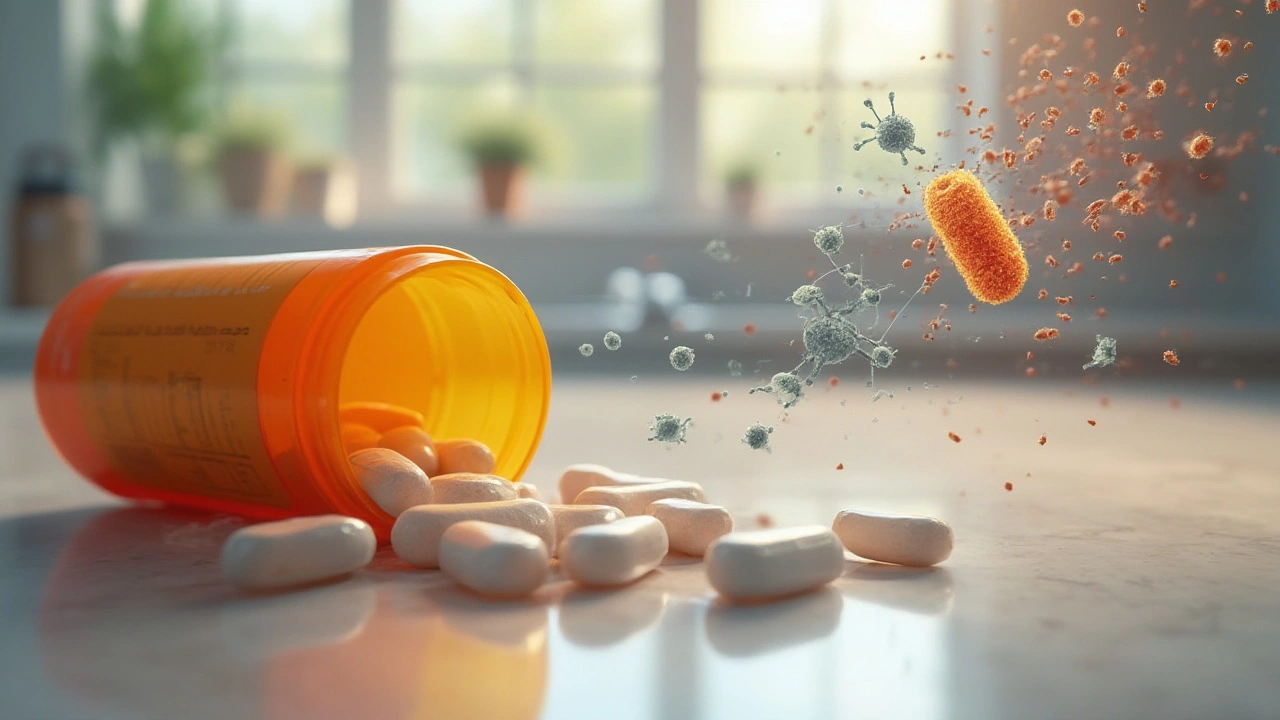Did you know the U.S. sees more than 250 million antibiotic prescriptions annually? That’s a staggering number. So, when your doctor mentions cefaclor, you’re in good company; it’s been around since the late 1970s and has helped millions fight stubborn infections. Cefaclor isn’t just another pill—it’s a second-generation cephalosporin, which means it's a bit like the upgraded big cousin of earlier antibiotics. If you’ve ever wondered why you can’t just grab any old antibiotic for sniffles or a sore throat, cefaclor’s story might change the way you look at your medicine cabinet.
What is Cefaclor and How Does It Work?
Let’s break it down. Cefaclor is part of the cephalosporin family—a group of antibiotics that target bacteria, not viruses like the flu or common cold. Picture bacteria as tiny troublemakers with protective walls. Cefaclor’s job? Burst right through these walls. It disrupts a key step in bacterial cell wall construction, causing the bacteria to weaken and die. Kind of like pulling out the framework from a house—it just can’t stand up anymore.
This is why cefaclor is so handy against infections in the respiratory tract, like bronchitis or sinusitis, and in the ears, skin, and even the urinary system. Doctors especially like it for kid-friendly dosing and a generally mild side effect profile. An interesting detail: cefaclor is available in immediate-release capsules, extended-release tablets, and even flavored oral suspensions for kids who gag at the thought of pills.
Not all bacteria are scared of cefaclor, though. It’s a strong choice for certain infections, but some superbugs have grown resistant. That’s why docs only pull out cefaclor when they’re pretty sure it’ll do the trick—and will steer clear in areas where resistance is an issue. Clinical studies from the early 2000s showed cefaclor performed especially well against bacteria like Haemophilus influenzae and Streptococcus pneumoniae, but less so against hardier, hospital-dwelling strains.
Check out how it stacks up against other antibiotics in this comparison table:
| Drug | Main Uses | Fun Fact |
|---|---|---|
| Cefaclor | Ear, throat, skin, urinary infections | Great for kids and mild allergies to penicillin |
| Amoxicillin | Respiratory, ear, urinary tract infections | Often first choice for kids' ear infections |
| Cephalexin | Skin, bone, urinary infections | Rarely used for bronchitis |
Cefaclor isn’t your “one size fits all” fix, but when it’s the right match, it works quietly and reliably in the background—no fanfare, just results.
When Is Cefaclor Prescribed?
If you’ve got bacterial tonsillitis or bronchitis that won’t budge, cefaclor often becomes the star of the show. It’s commonly prescribed for certain types of pneumonia, especially in kids or folks who can’t take penicillin. Got a sinus infection after a nasty cold? Sometimes cefaclor is just what the doctor orders—especially if previous antibiotics failed or the usual suspects are involved.
Urinary tract infections (UTIs) are a big area, too, mainly in those who have trouble with first-line antibiotics. Skin infections—think cellulitis or impetigo—respond pretty well, especially if caused by Streptococcus or Staphylococcus (but beware of MRSA). Otitis media, the dreaded childhood ear infection, is another spot where cefaclor shines. The American Academy of Pediatrics still lists it as a backup for hard-to-treat cases.
Interestingly, cefaclor isn’t usually a first-line option for simple infections. Docs keep it in their back pocket for when the regulars—like amoxicillin or cephalexin—can’t get the job done. This careful strategy slows down the creation of new resistant bacteria. There’s a bit of a domino effect: the more we use a single antibiotic, the higher the risk that bacteria figure out how to beat it. So cefaclor occupies a special role: valuable but used sparingly.
Here’s the catch—not everyone should reach for cefaclor. It does nothing for viral infections, so using it for, say, COVID-19 or a standard cold won’t just fail you but may also wreck your gut’s good bacteria. The CDC says about 30% of prescribed antibiotics are unnecessary, which is honestly wild. Taking cefaclor when you don’t need it just makes future infections harder to treat and can give you a rough time with side effects.
Ever seen that little pink liquid your child hates? Odds are good it was cefaclor or something similar. Pediatricians lean on it when simpler options won’t cut it and kids keep getting sick from daycare bugs. For adults, especially those with penicillin allergies, cefaclor can often be a good fallback (though it’s not totally safe for everyone with these allergies—see the next section).
Here are a few scenarios where cefaclor might pop up:
- Repeat ear infections in kids who can’t have penicillin
- “Stubborn” sinus infections that have lasted ten days or more
- Mild skin infections picked up during summer camping trips
- Urinary tract problems when first-line drugs have failed
While some doctors prescribe cefaclor for dental infections, it’s less common since other antibiotics work better for oral bacteria. But if you’ve got a quirky case, you might hear about it.

How to Take Cefaclor: Practical Tips and Advice
You’ve got your prescription in hand, and now you’re wondering what’s next. First rule: finish the course, even if you start feeling better halfway. Stopping early is the quickest way to invite bacteria back and, worse, make them stronger the next time. Most cefaclor prescriptions last 7 to 10 days, so set reminders on your phone if you’re forgetful like me.
Cefaclor’s absorption isn’t massively affected by food, but taking it with meals can help people with sensitive stomachs. If you’re using the suspension (that’s the liquid version for kids), shake it really well before each use. Bacteria don’t stand a chance if you use the right dose every single time. Use the official measuring spoon or cup that comes with the bottle—don’t wing it with a kitchen spoon because precision actually matters.
Dosewise, it usually goes something like this:
- Adults: 250mg to 500mg every 8 hours (three times a day)
- Kids: Dosing by weight, carefully measured for their size
Your doctor may tweak the schedule if you have kidney problems or if you’re switching from immediate-release to the extended-release tablet. Be honest with your doctor about all the meds and supplements you’re taking—vitamins, over-the-counter painkillers, even herbal teas. You never know what might interact. For example, antacids that contain aluminum or magnesium can slow down cefaclor’s absorption, making it less effective. Space those out by a couple hours if you must take both.
And let’s talk allergies. If you’ve ever had a reaction to penicillins or other cephalosporins, tell your doctor right away. About 10% of people allergic to penicillin can also react to cefaclor—itchy rash, swelling, or even trouble breathing. Not something you want to risk. If you notice anything odd like hives, severe diarrhea, or a weird taste in your mouth, call your provider.
Take a look at these key tips for using cefaclor safely:
- Always store the suspension in the fridge (it’s usable for 14 days after mixing)
- Leave the cap on tight to keep out moisture and light
- Don’t double up if you miss a dose—just take the next dose at the usual time
- Never share your antibiotics with others, even if symptoms seem similar
- Don’t flush leftover meds down the toilet—check for local take-back programs
One interesting tidbit: rare cases of serum sickness-like reactions (think fever, joint pain, and rash) have been reported, especially in kids. Usually, these go away when you stop the medication but let your healthcare provider know if anything feels off.
Side Effects, Warnings, and What to Watch For
No medicine is perfect, and cefaclor is no exception. Most folks tolerate it well, but you can run into headaches, nausea, stomach upset, mild diarrhea, or that metallic aftertaste. These side effects are usually mild, especially when you take your dose with food.
The red flags? Bloody stools, severe watery diarrhea, or persistent stomach pain could mean a serious gut reaction called C. difficile colitis. This happens because antibiotics wipe out some of your good gut bacteria, giving nasty germs more room to grow. If you have these symptoms, don’t wait—call your doctor right away. Rash, itching, or swelling may signal an allergy, which can get dangerous if left unchecked. And yes, even though it’s rare, anaphylaxis (a life-threatening reaction with swelling and breathing trouble) is possible. Hospitals keep adrenaline handy for just these situations.
Another quirky thing—some folks, especially children, have developed something called serum sickness-like syndrome, usually 1-2 weeks after starting cefaclor. This triggers joint soreness, swelling, and sometimes hives. It goes away once the medication stops, but it’s worth mentioning it if you or your child suddenly feels worse after a few good days.
If you’re pregnant or breastfeeding, cefaclor is considered a “Category B” drug in the U.S. FDA system. That means animal studies haven’t shown risks, but there aren’t enough human studies to say for sure. Usually, doctors will weigh the pros and cons, but this drug’s track record is pretty reassuring for short-term use. Kids and older adults can take cefaclor, but the dose needs to fit their size and kidney function.
Here’s a summary table of possible side effects and warnings:
| Possible Side Effect | How Common? | What to Do? |
|---|---|---|
| Nausea/stomach pain | Occasional | Take with food, tell your doctor if severe |
| Diarrhea | Common | Drink fluids, call if bloody or persistent |
| Rash/allergic reaction | Rare in adults, more in kids | Stop medication, call provider |
| Serum sickness-like symptoms | Rare | Usually goes away after stopping med |
If you’re mixing cefaclor with other drugs, always, always double-check with your pharmacist or healthcare provider. Blood thinners, other antibiotics, or some diabetes medicines can interact, leading to headaches you absolutely don’t need. print this article and keep it in your medicine drawer—sometimes tips like “store in fridge for suspensions” or “don’t double doses” slip the mind faster than you’d expect after a long day.
Most importantly, remember that antibiotics aren’t candy—respecting their use means they’ll still work when you (or your kid) really need them, now and years down the road.




7 Comments
Eric Pelletier
Cefaclor’s second-gen cephalosporin structure gives it broader Gram-negative coverage than cephalexin, especially against H. influenzae and Moraxella catarrhalis-key players in otitis media and sinusitis. But here’s the kicker: its beta-lactamase stability is decent, not stellar. If you’re dealing with ESBL-producing strains, you’re already past cefaclor’s pay grade. Also, the oral bioavailability is ~90%, which is solid for a cephalosporin, but food does slightly delay Tmax-so if you’re optimizing for peak serum levels, fasted state wins. Still, for pediatric use? The flavored suspension is a game-changer.
Marshall Pope
man i took this once for a sinus thing and my stomach felt like it was being rearranged by a toddler with a blender. also that pink liquid? absolute nightmare. i still gag thinking about it. but hey, it worked. so… thanks i guess?
Nonie Rebollido
my kid had 3 ear infections last year and this was the one the doc kept reaching for 😅 the pink stuff is gross but at least it didn’t make her vomit like amoxicillin did. thanks for the info!
Agha Nugraha
interesting read. i’ve seen this prescribed in my country too, especially for kids with penicillin allergies. seems like a solid middle-ground option.
Andy Smith
Important note: cefaclor’s renal clearance is primarily glomerular, with minimal tubular secretion-so dose adjustments are critical in patients with CrCl under 30 mL/min. Also, while cross-reactivity with penicillin is often cited as 10%, recent meta-analyses suggest it’s closer to 5–7% for non-anaphylactic reactions. And yes, the suspension must be refrigerated: at room temperature, degradation begins within 48 hours, reducing potency by up to 15% by day 7. Don’t skip the shake-particle settling affects dosing accuracy. Finally: never, ever use a kitchen spoon. A 5-mL calibrated dosing cup is non-negotiable.
Rekha Tiwari
Just wanted to say thank you for explaining this so clearly! 🙌 My niece got cefaclor last winter and I was so worried about the side effects, but knowing the signs (like bloody diarrhea or rash) helped me stay calm and know when to call the doctor. Also-yes, the pink stuff is the worst, but it’s better than IVs! 💕
Leah Beazy
This is the kind of post that makes me actually trust medical info online. So many people treat antibiotics like candy-but you laid it out like a real person who’s been through it. Also, the fridge tip? Genius. I’m printing this and taping it to my medicine cabinet. 💪